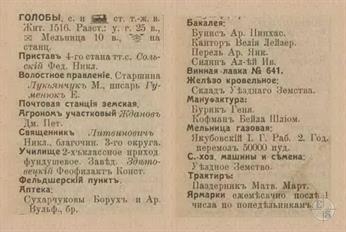Holoby
Kovel district, Volyn region
Sources:
- Russian Jewish encyclopedia;
- Holoby and Melnytsya: the life and death of Jewish communities / Petro Dolganov. - Kyiv: Ukrainian Center for Holocaust History, 2023. - 138 p.;
- The All South-Western Territory: reference and address book of the Kyiv, Podolsk and Volyn provinces. Printing house L.M. Fish and P.E. Wolfson, 1913.
Photo:
- Maryna Dolhanova. Holoby and Melnytsya: the life and death of Jewish communities. Illustrations;
- Суспільне Луцьк. На Волині руйнується Садиба Вільгів;
- Romashka58, Wikipedia. Голоби (станція)
- Russian Jewish encyclopedia;
- Holoby and Melnytsya: the life and death of Jewish communities / Petro Dolganov. - Kyiv: Ukrainian Center for Holocaust History, 2023. - 138 p.;
- The All South-Western Territory: reference and address book of the Kyiv, Podolsk and Volyn provinces. Printing house L.M. Fish and P.E. Wolfson, 1913.
Photo:
- Maryna Dolhanova. Holoby and Melnytsya: the life and death of Jewish communities. Illustrations;
- Суспільне Луцьк. На Волині руйнується Садиба Вільгів;
- Romashka58, Wikipedia. Голоби (станція)
Urban -type village (since 1957). Known from the 16th century. Since 1795 - as part of the Russian Empire. In 19 - beginning of the 20th century - in the Kovel district of the Volyn province. In 1919 –39 - in the Volyn Voivodeship as part of Poland, in 1939–91 - as part of the Ukrainian SSR.
In 1897, about 400 Jews lived in Holoby,
In 1921 - 200 (13,7%);
In 1931 - 350 Jews.
Jews lived in Holoby from the 2nd half of the 17th century.
There were no Jewish cemetery in Holoby, Jews were buried in a neighboring Melnytsya.
In 1897, about 400 Jews lived in Holoby,
In 1921 - 200 (13,7%);
In 1931 - 350 Jews.
Jews lived in Holoby from the 2nd half of the 17th century.
There were no Jewish cemetery in Holoby, Jews were buried in a neighboring Melnytsya.
 |
 |
| The former synagogue building, today the local pharmacy, 2023 | The monument to the murdered Jews of Holoby, restored in 2023 |
The Germans occupied Holoby on June 29, 1941. 3 Jews were killed at once.
Jews of Melnytsia and Holoby were attracted to grain harvesting on elevators, construction and repair of roads, work on railways, street cleaning and more. The Jews were most often monitored by local Ukrainians and Poles during the performance of these works.
In the spring of 1942, a ghetto was created. Most likely, the ghetto was liquidated in late August - early September 1942, during the action of the shooting of the Holoby Jews together with the Jews of Melnitsa.
Unknown exactly where were murdered several hundreds of Holoby Jews: some sources mentioned their convoy to Melnytsya, in others - to the Zabirya forest near Holoby themselves.
Jews of Melnytsia and Holoby were attracted to grain harvesting on elevators, construction and repair of roads, work on railways, street cleaning and more. The Jews were most often monitored by local Ukrainians and Poles during the performance of these works.
In the spring of 1942, a ghetto was created. Most likely, the ghetto was liquidated in late August - early September 1942, during the action of the shooting of the Holoby Jews together with the Jews of Melnitsa.
Unknown exactly where were murdered several hundreds of Holoby Jews: some sources mentioned their convoy to Melnytsya, in others - to the Zabirya forest near Holoby themselves.

- Home
- Shtetls
- Vinnytsia region
- Volyn region
- Dnipro region
- Donetsk region
- Zhytomyr region
- Zakarpattia region
- Zaporizhzhia region
- Ivano-Frankivsk region
- Kyiv region
- Kropyvnytskyi region
- Luhansk region
- Lviv region
- Mykolayiv region
- Odessa region
- Poltava region
- Rivne region
- Sumy region
- Ternopil region
- Kharkiv region
- Kherson region
- Khmelnytskyi region
- Chernihiv region
- Chernivtsi region
- Cherkasy region
- Crimea
- Synagogues
- Cemeteries
- Objects & guides
- Old photos
- History
- Contact
Jewish towns of Ukraine
Jewish towns of Ukraine
My shtetl
My shtetl
Donate



